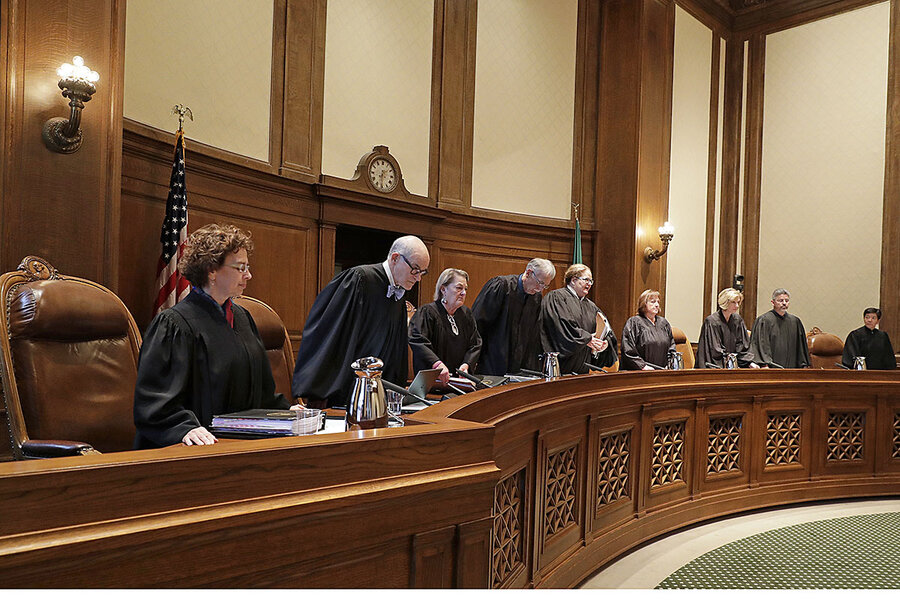Why more states are giving juvenile offenders a second chance
Loading...
When Marshan Allen was a teen in Chicago, he says he faced a tough choice: Go to class or help his older brother. The issue: His brother was selling drugs, as were many people on the South Side of Chicago in the 1990s.
“I was surrounded by cocaine.... My mom, my uncle, the neighborhood,” he says. “My older brother James began selling drugs, and I was doing chores for him to make extra money.”
One day in March 1992 he stole a van. Two of his brother’s friends drove it during a bungled drug deal in which they killed two teenagers. Mr. Allen stayed in the van during the killing, according to court documents, but he was still convicted on two counts of first-degree murder. That’s because of a legal theory of accountability that said an accomplice could be sentenced to the same crime as the chief perpetrator.
Why We Wrote This
More attention is being given to the idea that young offenders can still make radical changes to their mind-set. As a result, measures aimed at rehabilitating juvenile prisoners instead of locking them up for the rest of their lives are spreading across the United States.
The judge sentenced Allen to life in prison without the possibility of parole. He was 15. At the time, with crime rates surging, lawmakers in both parties argued that juveniles who committed “adult crime” deserve “adult time.”
“I was crying like a baby,” Allen says. “I should be held accountable for my crime, but I didn’t think that specific sentence was fair.”
Ultimately, neither did the United States Supreme Court. In 2012, the court ruled in Miller v. Alabama that the mandatory sentencing of juveniles to life without the possibility of parole was unconstitutional. The youngest offenders have “diminished culpability and greater prospects for reform,” and to require those mandatory sentences without considering features of youth constitutes cruel and unusual punishment, Justice Elena Kagan wrote.
This ruling was followed by a 2016 decision that applied Miller retroactively to all prisoners given mandatory sentences of life without parole as juveniles. Thousands of inmates were suddenly up for resentencing, and juvenile justice experts say it helped begin a nationwide reform of juvenile sentencing in state legislatures and courts.
“In so many ways, states are rolling back the mistakes of the 1980s and 1990s [and realizing] that when young people make mistakes, they are still capable of rehabilitation,” says Joshua Rovner, senior advocacy associate at The Sentencing Project in Washington. “Young people in general are entitled to fairness and opportunities to reform.”
Before 2012, only a handful of states did not use guidelines for mandatory life sentences without parole. Today not only are the mandatory sentences gone, 21 states and the District of Columbia prohibit judges from sentencing any juveniles to life without parole – most recently in Washington State, whose Supreme Court found that the sentence violated the state’s constitution in October.
The shift comes at a time of movement away from incarceration in the juvenile justice system toward second chances, as more is learned about how young minds develop until age 25. In the process, some states are moving toward newer forms of accountability, such as offering more opportunities for mediation between a victim and a perpetrator.
“We’ve made incarceration such a normal thing in this country that sending a young person away for any period of time, especially kids of color, wasn’t considered an unusual thing,” says Marc Schindler, executive director of the Justice Policy Institute in Washington. “[W]hat we’ve seen recently is a swing in juvenile courts from a punitive approach to more treatment.”
One of the first states to heavily invest in “community-based alternatives” was Missouri. About 30 years ago, the state started replacing youth prisons with a continuum of care, from treatment centers to secure residential facilities in Missouri’s state parks. Since 2013, it has reported a steadily declining rate of commitments and recommitments; overall, Missouri has one of the lowest youth recidivism rates in the country.
There’s also a push nationwide for young adults to have more access to therapeutic social services. Connecticut, South Carolina, and the District of Columbia are all pioneering forms of treatment for those between the ages of 18 and 24 in adult prisons.
While broad changes are shifting the juvenile justice system toward rehabilitation, and Congress may be looking at the first real criminal justice reform in a generation with the First Step Act, many states that once gave mandatory life sentences to youth are now using de facto life sentences of 40 to 60 years. The courts have yet to take up the constitutionality of those sentences.
“There are people who think that the criminal justice system can solve problems that it isn’t able to. That you can just lock people up, but that doesn’t work,” said Mr. Rovner.
In Illinois, Allen spent 24 years, eight months, and two days behind bars before the Supreme Court ruling enabled him to earn his release. Before his release in 2017, he got his GED certificate, a paralegal certificate, a business management certificate – even an associate degree. “It wasn’t always easy to do something positive in a very negative environment. There’s a lot of misery there from the guards and the prisoners,” says Allen. Now, he works as a project manager for the Restore Justice Foundation in Chicago, where he is lobbying to pass a bill to restore parole opportunities for children facing sentences longer than 10 years. “It was a great feeling to come home and be out of that place and know I was able to start my life over again – to start anew.”






